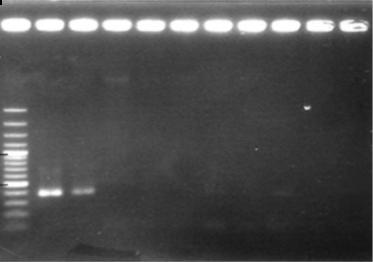Simple protocol to extract DNA from bone fragments-A preliminary study
Main Article Content
Abstract
DNA extraction from bone samples is greatly useful for forensic applications but it is more diffi cult to be conducted compared with extracting DNA from other tissues due to rigid structure of the bones and contamination from the environment, such as, bacterial colonization within bone tissues. This research aimed to determine a simple and cost-effective protocol for extracting DNA from bone fragments. Canine leg bones were used as samples and canine Glyceraldehyde-3-phosphate dehydrogenase (GAPDH) gene-specifi c primers were used to confi rm successful DNA extraction through PCR. We developed a protocol that was able to extract DNA from “fresh” as well as “old” bones that had been buried in soil or stored underwater in a pond for three months. Although the effectiveness decreased in the old bones, this protocol only requires common devices and chemicals readily available in general molecular laboratories and can be completed in less than 24 hours, offering an alternative lower-cost and less time intensive method for forensic research.
Article Details
Publishing an article with open access in Veterinary Integrative Sciences leaves the copyright with the author. The article is published under the Creative Commons Attribution License 4.0 (CC-BY 4.0), which allows users to read, copy, distribute and make derivative works from the material, as long as the author of the original work is cited.
References
Fondevila, M., Phillips, C., Naveran, N., Fernandez, L., Cerezo, M., Salas, A., … Lareu, M. V. (2008). Case report: identifi cation of skeletal remains using short-amplicon marker analysis of severely degraded DNA extracted from a decomposed and charred femur. Forensic Science International. Genetics, 2(3), 212–218.
González-Andrade, F., & Sánchez, D. (2005). DNA typing from skeletal remains following an explosion in a military fort--fi rst experience in Ecuador (South-America). Legal Medicine (Tokyo, Japan), 7 (5), 314–318.
Hochmeister, M. N. (1995). DNA technology in forensic applications. Molecular Aspects of Medicine, 16(4), 315–437.
Imaizumi, K., Noguchi, K., Shiraishi, T., Sekiguchi, K., Senju, H., Fujii, K., … Yoshino, M. (2005a). DNA typing of bone specimens--the potential use of the profi ler test as a tool for bone identifi cation. Legal Medicine (Tokyo, Japan), 7 (1), 31–41.
Imaizumi, K., Noguchi, K., Shiraishi, T., Sekiguchi, K., Senju, H., Fujii, K., … Yoshino, M. (2005b). DNA typing of bone specimens--the potential use of the profi ler test as a tool for bone identifi cation. Legal Medicine (Tokyo, Japan), 7 (1), 31–41.
Jones, H. (2007). Meeting Report: Advances In Forensic DNA Analysis. Scientifi c Journals, (47), 4.
Khosravinia, H., & Ramesha, K. P. (2007). Infl uence of EDTA and magnesium on DNA extraction from blood samples and specifi city of polymerase chain reaction. African Journal of Biotechnology, 6 (3).
Latham KE, Ritke MK. (2002). Bone DNA purifi cation protocols for genetic analysis. University of Indianapolis Archeology and Forensics Laboratory (Indiana). Available from: http://archlab.uindy.edu/ documents/DNAPurifi cation.pdf
Loreille, O. M., Diegoli, T. M., Irwin, J. A., Coble, M. D., & Parsons, T. J. (2007). High effi ciency DNA extraction from bone by total demineralization. Forensic Science International. Genetics, 1(2),
191–195.
http://doi.org/10.1016/j.fsigen.2007. 02.006 Pusch, C., & Scholz, M. (1997). DNA extraction from ancient human bones via enzymatic treatment. Technical Tips Online, 2(1), 160–163.
Siengdee, P., Nganvongpanit, K., Pothacharoen, P., Chomdej, S., Mekchay, S., & Ong-Chai, S. (2010). Efects of bromelain on cellular characteristics and expression of selected genes in canine in vitro chondrocyte culture. Veterinarni Medicina, 55(11).
Yang, D. Y., Cannon, A., & Saunders, S. R. (2004). DNA species identifi cation of archaeological salmon bone from the Pacifi c Northwest Coast of North America. Journal of Archaeological Science, 31(5), 619–631.

